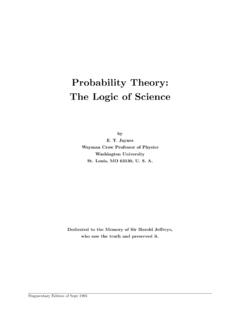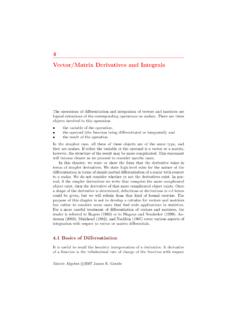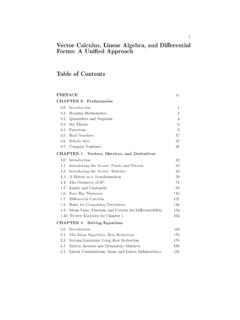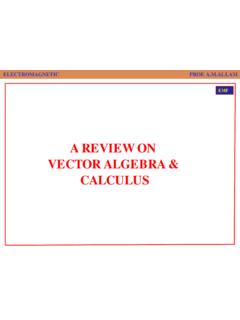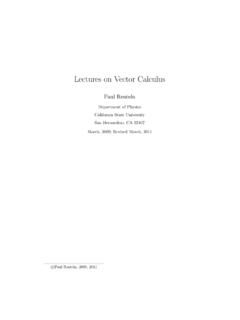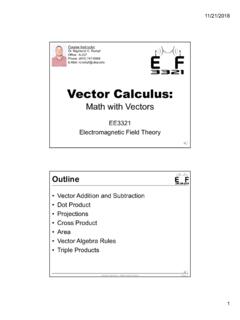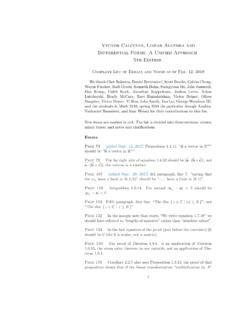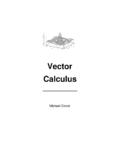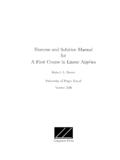Transcription of Vector Calculus - University at Albany, SUNY
1 -10-5 0 5 10-10-5 0 5 0 1zxyzVectorCalculusMichael CorralVector CalculusMichael CorralSchoolcraft CollegeAbout the author:Michael Corral is an Adjunct Faculty member of the Departmentof Mathematicsat Schoolcraft College. He received a in Mathematics from the Universityof California at Berkeley, and received an in Mathematics and an inIndustrial & Operations Engineering from the University of text was typeset in LATEX2 with theKOMA-Scriptbundle, using the GNUE macs text editor on a Fedora Linux system. The graphics were created usingMetaPost, PGF, and 2008 Michael is granted to copy, distribute and/or modify thisdocument under the termsof the GNU Free Documentation License, Version or any later version publishedby the Free Software Foundation; with no Invariant Sections,no Front-Cover Texts,and no Back-Cover Texts.
2 A copy of the license is included in the section entitled GNU Free Documentation License .PrefaceThis book covers Calculus in two and three variables. It is suitable for a one-semestercourse, normally known as Vector Calculus , Multivariable Calculus , or simply Calculus III . The prerequisites are the standard coursesin single-variable Calculus ( Calculus I and II).I have tried to be somewhat rigorous about proving results. But while it is impor-tant for students to see full-blown proofs - since that is how mathematics works - toomuch rigor and emphasis on proofs can impede the flow of learning for the vast ma-jority of the audience at this level. If I were to rate the levelof rigor in the book on ascale of 1 to 10, with 1 being completely informal and 10 being completely rigorous, Iwould rate it as a are 420 exercises throughout the text, which in my experience are more thanenough for a semester course in this subject.
3 There are exercises at the end of eachsection, divided into three categories: A, B and C. The A exercises are mostly of aroutine computational nature, the B exercises are slightlymore involved, and the Cexercises usually require some effort or insight to solve. Acrude way of describing A,B and C would be Easy , Moderate and Challenging , respectively. However, manyof the B exercises are easy and not all the C exercises are are a few exercises that require the student to write hisor her own com-puter program to solve some numerical approximation problems ( the Monte Carlomethod for approximating multiple integrals, in Section ). The code samples in thetext are in the Java programming language, hopefully with enough comments so thatthe reader can figure out what is being done even without knowingJava. Those exer-cises do not mandate the use of Java, so students are free to implement the solutionsusing the language of their choice.
4 While it would have been simple to use a script-ing language like Python, and perhaps even easier with a functional programminglanguage (such as Haskell or Scheme), Java was chosen due to its ubiquity, relativelyclear syntax, and easy availability for multiple and hints to most odd-numbered and some even-numbered exercises areprovided in Appendix A. Appendix B contains a proof of the right-hand rule for thecross product, which seems to have virtually disappeared from Calculus texts overthe last few decades. Appendix C contains a brief tutorial onGnuplot for graphingfunctions of two book is released under the GNU Free Documentation License(GFDL), whichallows others to not only copy and distribute the book but alsoto modify it. For moredetails, see the included copy of the GFDL. So that there is no ambiguity on thisiiiivPrefacematter, anyone can make as many copies of this book as desiredand distribute itas desired, without needing my permission.
5 The PDF version willalways be freelyavailable to the public at no cost (go ). Feel free tocontact me any questions on this or any othermatter involving the book ( comments, suggestions, corrections, etc). I welcomeyour , I would like to thank my students in Math 240 for beingthe guinea pigsfor the initial draft of this book, and for finding the numerous errors and typos 2008 MICHAELCORRALC ontentsPrefaceiii1 Vectors in Euclidean Introduction .. Vector Algebra .. Dot Product .. Cross Product .. Lines and Planes .. Surfaces .. Curvilinear Coordinates .. Vector -Valued Functions .. Arc Length .. 592 Functions of Several Functions of Two or Three Variables .. Partial Derivatives .. Tangent Plane to a Surface .. Directional Derivatives and the Gradient.
6 Maxima and Minima .. Unconstrained Optimization: Numerical Methods .. Constrained Optimization: Lagrange Multipliers .. 963 Multiple Double Integrals .. Double Integrals Over a General Region .. Triple Integrals .. Numerical Approximation of Multiple Integrals .. Change of Variables in Multiple Integrals .. Application: Center of Mass .. Application: Probability and Expected Value .. 1284 Line and Surface Line Integrals .. Properties of Line Integrals .. Green s Theorem .. Surface Integrals and the Divergence Theorem .. Stokes Theorem .. Gradient, Divergence, Curl and Laplacian .. 177 Bibliography187 Appendix A: Answers and Hints to Selected Exercises189 Appendix B: Proof of the Right-Hand Rule for the Cross Product192 Appendix C: 3D Graphing with Gnuplot196 GNU Free Documentation License201 History209 Index2101 Vectors in Euclidean IntroductionIn single-variable Calculus , the functions that one encounters are functions of a vari-able (usuallyxort) that varies over some subset of the real number line (which wedenote by ).
7 For such a function, say,y=f(x), thegraphof the functionfcon-sists of the points(x,y)=(x,f(x)). These points lie in theEuclidean plane, which,in theCartesianorrectangularcoordinate system, consists of all ordered pairs ofreal numbers(a,b). We use the word Euclidean to denote a system in which all theusual rules of Euclidean geometry hold. We denote the Euclidean plane by 2; the 2 represents the number ofdimensionsof the plane. The Euclidean plane has twoperpendicularcoordinate axes: thex-axis and Vector (or multivariable) Calculus , we will deal with functions of two or three vari-ables (usuallyx,yorx,y,z, respectively). The graph of a function of two variables, say,z=f(x,y), lies inEuclidean space, which in the Cartesian coordinate system consistsof all ordered triples of real numbers(a,b,c). Since Euclidean space is 3-dimensional,we denote it by 3.
8 The graph offconsists of the points(x,y,z)=(x,y,f(x,y)). The3-dimensional coordinate system of Euclidean space can be represented on a flat sur-face, such as this page or a blackboard, only by giving the illusion of three dimensions,in the manner shown in Figure Euclidean space has three mutually perpendic-ular coordinate axes (x,yandz), and three mutually perpendicular coordinate planes:thexy-plane,yz-plane andxz-plane (see Figure ).xyz0P(a,b,c)abcFigure 1. VECTORS IN EUCLIDEAN SPACEThe coordinate system shown in Figure is known as aright-handed coordi-nate system, because it is possible, using the right hand, to point the index finger inthe positive direction of thex-axis, the middle finger in the positive direction of they-axis, and the thumb in the positive direction of thez-axis, as in Figure coordinate systemAn equivalent way of defining a right-handed system is if youcan point your thumbupwards in the positivez-axis direction while using the remaining four fingers torotate thex-axis towards they-axis.
9 Doing the same thing with the left hand is whatdefines aleft-handed coordinate system. Notice that switching thex- andy-axesin a right-handed system results in a left-handed system, and that rotating eithertype of system does not change its handedness . Throughoutthe book we will use aright-handed functions of three variables, the graphs exist in 4-dimensional space ( 4),which we can not see in our 3-dimensional space, let alone simulate in 2-dimensionalspace. So we can only think of 4-dimensional space abstractly. For an entertainingdiscussion of this subject, see the book by far, we have discussed thepositionof an object in 2-dimensional or 3-dimensionalspace. But what about something such as the velocity of the object, or its acceleration?Or the gravitational force acting on the object? These phenomena all seem to involvemotion anddirectionin some way.
10 This is where the idea of avectorcomes thing you will learn is why a 4-dimensional creature wouldbe able to reach inside an egg andremove the yolk without cracking the shell! Introduction3 You have already dealt with velocity and acceleration in single-variable example, for motion along a straight line, ify=f(t)gives the displacement ofan object after timet, thendy/dt=f (t)is the velocity of the object at timet. Thederivativef (t)is just a number, which is positive if the object is moving in anagreed-upon positive direction, and negative if it moves in the opposite of that direction. Soyou can think of that number, which was called the velocity of the object, as havingtwo components: amagnitude, indicated by a nonnegative number, preceded by adirection, indicated by a plus or minus symbol (representing motion inthe positivedirection or the negative direction, respectively), (t)= afor some numbera the magnitude of the velocity (normally called thespeedof the object), andthe represents the direction of the velocity (though the+is usually omitted for thepositive direction).

